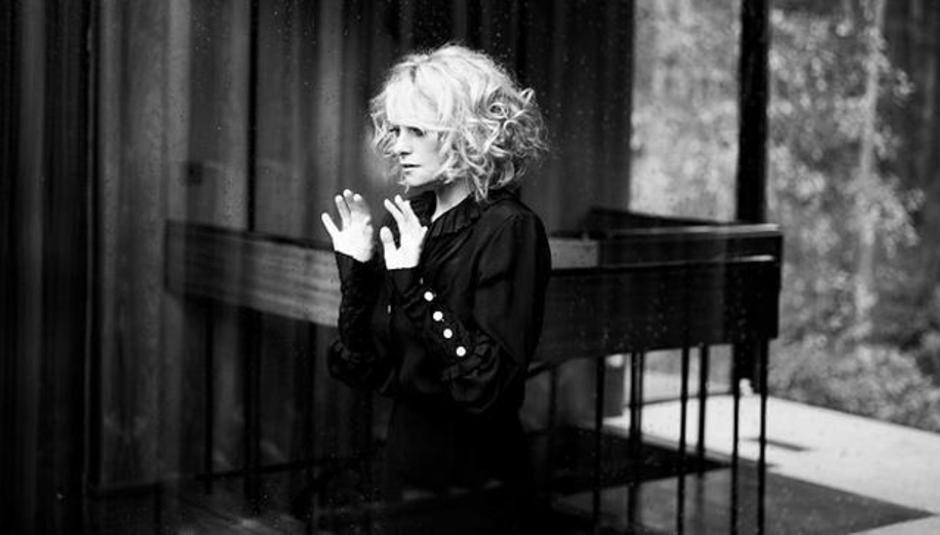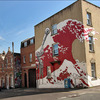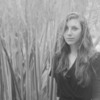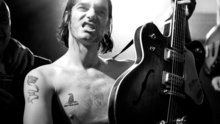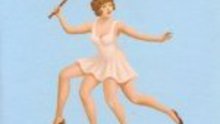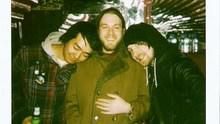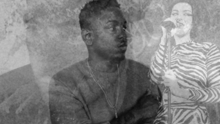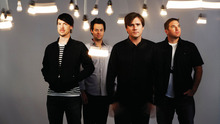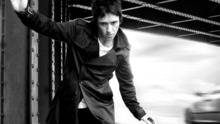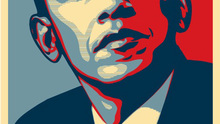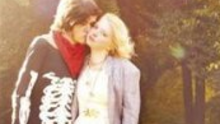“Hellooooo, Drowned In Sound’”, Alison Goldfrapp purrs down the telephone line. As the rays trickle in through the window from the last of the summer they create a contrasting landscape to the monochrome outlines Alison and her professional other half Will Gregory have sketched for their latest album, Tales Of Us.
Self-admittedly dissatisfied with their last album Head First, Tales Of Us sees Goldfrapp shedding the sequins and glam to once again roam the bare terrain they first scaled on Felt Mountain and Seventh Tree to dramatic effect. Focusing on picked acoustics, bare piano and sweeping strings, the record evokes a beguiling and haunted world that's a lifetime away from the technicolour path the band has previously walked.
It’s a change in direction partly facilitated by Goldfrapp, following the release of Head First, moving back to their old label Mute after an ill-fitting stint on EMI. A move that importantly granted them the artistic license they needed to spend two years researching and finessing what would be Tales Of Us.
The backbone of the record is Alison’s love affair with storytelling - looking to Patricia Highsmith novels, films by David Lynch, Ingmar Bergman and Michelangelo Antonioni, and European music - she takes a narrative backseat to tell the tales of protagonists named in nine out of the ten tracks. 'Annabel', taking inspiration from Kathleen Winter’s novel of the same name, recites the story of an intersex baby raised as a boy, whilst ‘Simone’ speaks of an occurrence of a woman arriving home to find her lover in bed with her daughter. Rather than instant highs of Goldfrapp’s past lyrical forays, Tales Of Us, leads you through a more complex web of emotions.
Always strong on visuals, this focus on storytelling also extends into the videos accompanying the album. Two stunning black and white films for ‘Drew’ and 'Annabel' produced by Alison’s partner, the filmmaker Lisa Gunning, have already been released. Three more films are set to follow, culminating with all five films being released at the end of the year.
Speaking to Alison she explains the vital role storytelling played in the Tales Of Us, the band’s continued manipulation of visual media and the importance of creative freedom. Just don’t mention the word ‘strategy’.
The video for ‘Annabel’ was showcased recently on Nowness. Were you pleased with how it’s been received?
It’s been amazing, lovely. It’s so nice when people feel the same way that you do about something, it’s a nice feeling. It’s been lovely.
The video for ‘Annabel’ is described as a tale of a young, androgynous boy exploring his femininity. Was this the inspiration for the song as well as the video? Is it one collective piece?
The song was inspired by the book called ‘Annabel’, which is about a child that’s born intersex. Our video is set in a much more pastoral, English, sun-dappled world, whereas in the book actually it’s in this amazing, epic, bleak landscape of northern Canada, which gives such a wonderful atmosphere to the book. Unfortunately we don’t have the money to travel to northern Canada so we couldn’t do that! The film is our interpretation of the feeling of the song and the book.
Who was the author of the book, ‘Annabel’?
Kathleen Winter.
Throughout your career you’ve consistently had a strong visual presence. For this album it does seem like more of an overt strategy to link the music with specific visuals as you are releasing five short films to accompany five songs from the album. Why are visuals so important to you?
First of all it wasn’t really a strategy - we made films to songs we wanted to make them to. The very first thing we made was a film for ‘Joe’ and then ‘Annabel’; ‘Annabel’ wasn’t going to be a priority or anything for the record company but ‘Annabel’ was just a story that I really wanted to tell visually... so there wasn’t really a strategy there at all…
‘Strategy’ was probably a bad choice of words, it makes it sound really cold and calculating, it was more as in the ‘thinking’ behind it...
As in a marketing plan. It was very much wanting to make a film - I didn’t want to do a video again. It’s that and also what do we want to visually to tell the story, rather than if it’s going to be a single or anything. That’s where it came from in the beginning and then it kind of grew.
The visuals for this album compared to the presentation of your last album, Head First - where in the video for the singe ‘Alive’ you were dressed as a aerobics instructor - are at completely different ends of the spectrum.
Yes, good. I’m so pleased about that.
I did read a quote on The Guardian's website where you said that you weren’t keen on Head First, which seems like a startling thing to say for an album so recent.
There’s lots of reasons, but you know what I feel. I’ve spoken so much about it - I’ve said enough about it now so I won’t expand about it.
On your website there’s an apt analogy for your career where it describes you as being like two sides of the same coin as you have released albums that are very different in character - like releasing Supernature alongside an album like Seventh Tree. It’s quite an achievement that you manage to balance both sides and it's something your fans accept. How important is it to you to be able to explore both sides?
I think it’s always important to feel that you’ve got creative freedom and we’re very lucky to be with a record company that’s always been very supportive of whatever creative decisions we’ve made - for better or worse. For me, the most important thing is to have freedom and that’s what creativity is - it’s about discovery. Sometimes you make things you think ‘that wasn’t very good’, or ‘I’m not sure about that’ and make mistakes and you carry on and that’s what creative freedom is and we’ve been lucky to have that.
On the last album it was an unfortunate time with a major record company, i.e EMI. We were rushed and things didn’t go the way we wanted them to go, but we’ve resigned with Mute who are independent again and we’re back to being able to take things where we want to take them.
I was reading a quote online by Nicole Blonder, Mute’s Head of Marketing and Sales, where she said: "It's a very album-focused strategy. The band sees it as a collection of stories", whereas before it seems like you may have been being pushed to be a singles band. It seems rare to get that support, especially in a time where albums are undervalued. It does seem like they’re very much on your side.
They’re really wonderful, Mute.
Tales Of Us is centered around the names of people, bar one song called ‘Stranger’. Why did you decide to name the songs after people?
I just was very inspired by books and film and I love immersing myself in a story and I really wanted to make music that was like that. I like the feeling of being in a character and telling a story of that person. That’s what inspired it - the books that I was reading and the films I was watching - and I hope we’ve achieved that or at least a little bit of that.
By writing stories about other people was it a conscious decision to not write about yourself anymore?
Well, I have done that quite a lot. I always mix fantasy and the personal together but I just enjoyed immersing myself in someone else’s world.
For this album the creative process was over two years, whereas your last album was recorded in just six months. How important is it to you to be able to read and research?
Musically, we spend a lot of time arranging and I think anything that is rushed is never good. It’s great to create deadlines for yourself and targets and all that stuff but I think it’s important to take your time and maybe go back to them a couple of weeks later so you’re not just some kind of factory line. I’m not into that at all. I don’t feel comfortable. I don’t feel it’s really conducive to creativity that kind of rushing.
It seems the opposite to what creativity is supposed to be...
Sometimes things happen really quickly. Sometimes ideas form and come very quickly but you have time to nurture it and make it into something. It’s one thing having an idea, but it needs to be nurtured.
I was reading Neil Young’s autobiography recently and he talks about following ‘the muse’ and during the course of the book he has a period of six months where he doesn’t write any songs. It’s a way of thinking that’s in direct opposition to now where music is produced and released so quickly. It seems a bizarre line of thinking to say 'I’m going to wait until I have the creative inspiration to do it' and devote the necessary time to do it.
It’s a balance, isn’t it? Sometimes I think it’s really good to work through things if you’re not in the mood for it. I think sometimes that can be good and you can push through a barrier – everyone’s got their own way of doing it. I do think it’s nice to be able to look at something and then look at it again with a bit of time left inbetween, because you look at it again and you see it with different eyes or ears.
You’ve said that the album was particularly inspired by Patricia Highsmith, David Lynch and Ingmar Bergman. What attracted you to these people or have they been longstanding influences?
They have really, yes. They’re kind of brilliant.
How do you think they impacted this album?
It was a mixture of all sorts of things. For me, music is very visual... I don’t know how to explain it, in fact, I can’t explain it. I would say that the visuals don’t just inspire the lyrics they inspire sound and atmosphere and narrative and all sorts of things.
You’ve said before that you favour acoustic instruments as they have “a warmth and sensuality about them”, whereas electronic sounds have “an iciness”. This album does seem to be focused more on picked acoustic guitar, piano and strings. Was that dictated to by where the lyrics were coming from that you needed warm music to compliment the stories being told?
No, because not one thing comes first. It’s not like I sit there and write all the lyrics and then the music gets written,. It’s a bit of both. They’re working constantly in tandem with each other. Will and I spend a lot time jamming and improvising. Sometimes I’ll go away for couple of days and write lyrics and then we’ll be back in the studio together and carry on writing. It’s this constant flow of things happening and evolving simultaneously.
When you started to record did you both come in and have the shared viewpoint that you wanted to do something completely different to Head First?
Well, I had a very strong idea about what I wanted to do and the sound I wanted to make and I wanted to do something that was much more stripped back than we’d done on previous albums. The kind of singer-songwriters that I like listening to are very much in that sound world of acoustic guitar, voice or strings and piano and I really wanted to do something with that simplicity and space.
What particular artists were you influenced by?
I love music, I love listening to all kinds of music, but there’s no one particular artist.
You released a ‘Goldfrapp: Tales of Us’ app, which allows users to combine two of photos using the ‘double exposure’ photography technique. Why did you choose to do the app? How important is it to you to have this type of dialogue with your fans?
It is important for me to have that dialogue - I kind of enjoy it. With this album, in particular, it sort of lent itself to visual things like the app – it’s such great fun to do things like that. I like having a direct dialogue with fans, it just a really nice thing to be able to do. I like all these other elements you can be involved in, other creative ways of expression, I just love the app as it feels like such a fun thing and it’s also creative.
I love the whole idea of being able to spontaneously change an image and I think that’s such a great thing for people to be involved in. It’s been really great looking at the stuff people have sent in. You muck around with an image and it turns into something completely different and it’s very spontaneous. Those things just come about really - there’s no great plan - ideas just pop out and you just think, ‘yeah, that’d be great to do’. There seems to be a lot of things bubbling away, which is wonderful.
You played the Manchester International festival on 17 and 18 July accompanied by the Royal Northern College of Music string orchestra. What was it like to play with a full string orchestra?
Amazing. We were actually asked to do that and it was such a wonderful thing to be able to do. In my dream world I’d like to go on tour with an orchestra - that’d be amazing and just play songs from the new album - but we can’t afford to do that! Any opportunity to be able to play with an orchestra I just jump at the chance as it’s such a wonderful feeling to be with lots of musicians on stage. It’s a great feeling, I love it.
So, for the upcoming UK tour you can’t really take an orchestra on the road then?
Oh god, no! Not even half of one, unfortunately.
Your style for this album seem quite muted from your previous stage clothes. For the summer shows you wore a long black gown or black trousers and a black cape. Why did you decide to go for this particular image?
I think I just wanted to sort of wipe the slate clean - I love silhouette, I love shape – I feel like I’m not really into big costume things, at the moment, I’m into something quite simple and graphic. I can’t explain why particularly, it’s just a thing I’m feeling at the moment. It might change, but I feel good like that and feel very comfortable with – it’s the look I’m into at the moment.
Your music and look has been imitated a lot in the past. Do you take that as flattery or do you think, “you’ve nicked my look and my songs”?
Haha, erm no. I think it’s all wonderful that people 'nick' my ...[laughs]. I can think of people who have probably directly taken something and I’ve thought “ooh, that’s interesting they’re wearing a pierrot roux.” But, I think it’s all good. Y’know what, everybody’s influenced or inspired by someone and takes looks and transforms and makes them into their own looks - it’s very human to do that and we all do it - so, it’s fine, I’m absolutely fine with it and it is flattering of course.
Tales Of Us is out now on Mute.

